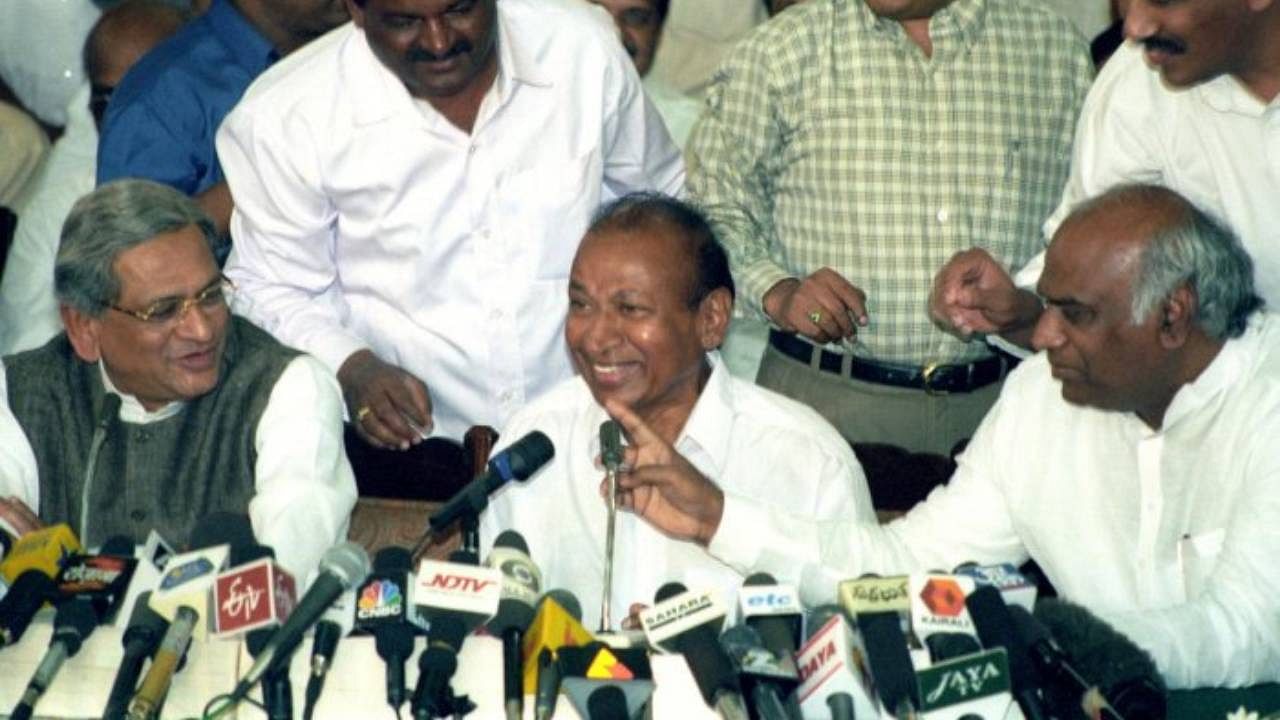
The new chief minister arrives at the entrance to the Vidhana Soudha. His home minister comes next. Instead of walking into the majestic building for the first cabinet meeting, the CM puts his arm around the home minister, walks to the other side of (former CM) Kengal Hanumanthaiah’s statue for a long conversation in full glare of television cameras.
This was S M Krishna using optics to tell all that though he could not get approval for Mallikarjun Kharge as his deputy CM, he would, and did, consult him in all decision-making. “It is just to show that Kharge is the second among equals,” a close associate of Kharge said.
The common perception was Kharge worked hard as Leader of the Opposition during the Janata Dal government. But just before elections, Krishna was appointed state Congress president and then CM. The Congress won on the ‘Panchajanya’ bus joint campaign. “We are united in the bus,” a bemused K H Ranganath had quipped to this reporter.
Political equations changed when simultaneous elections were held to the Lok Sabha and the state assembly in 1999. Outgoing CM J H Patel joined hands with Ramakrishna Hegde’s Lok Shakti and George Fernandes’ Samata Party to contest on a BJP-headed NDA platform. Deve Gowda formed the Janata Dal (Secular) to oppose this and the Patel faction became the JD (United). The voters showed their disenchantment with the factionalism by giving Congress 132 seats, BJP 44, JDU 18 and JDS 10 in the state assembly.
For the Lok Sabha elections, the pitch was Videshi vs Swadeshi as BJP’s Sushma Swaraj ran a high-voltage campaign seeking to defeat Congress’ Sonia Gandhi in Bellary. Sonia won, but the BJP managed to enter every village in the district. Of the 28 seats, Congress got 18, BJP seven and JD (U) three.
Krishna’s tenure was crisis-ridden. Sandalwood smuggler Veerappan kidnapped Dr Rajkumar and plunged the state into violent protests, arson, fan suicides, and tension for 108 days. Krishna went on All India Radio to make a personal appeal for the release the Kannada icon, who finally came home after negotiations by Tamil tabloid Nakkeran’s editor R Gopal. Though never confirmed, it was said that Veerappan was paid a king’s ransom by the state, the film industry and the thespian’s family.
The following year Veerappan kidnapped H Nagappa, the MLA of Hanur in Chamarajanagar. Negotiations broke and Nagappa was killed. When the joint state task force of Karnataka and Tamil Nadu, headed by K Vijaykumar, killed Veerappan, there was palpable relief for the Krishna government. But not before damage to his image.
When Krishna was informed that IT czar Azim Premji was seen buying corn from a street vendor on M G Road, he went into “tough” dinner diplomacy, as he called it, to ensure both Premji and Infosys founder Narayana Murthy accepted security to prevent further ransom bids. He focussed on “performing like a CEO” of a corporate entity to turn Bengaluru into Singapore. The rest of the state would benefit from the enhanced revenue generated from the capital, he believed.
His tenure saw the IT sector grow agnostic of government policies. The growth continued in subsequent years when coalition politics became all about staying alive. His support for IT growth and primacy for a public-private partnership model put Brand Bangalore on the global map. Andhra Pradesh Chief Minister Chandrababu Naidu tried to pit Hyderabad against Bengaluru and succeeded to an extent.
Some say Krishna’s Bengaluru-centric administration became his line to defeat when he opted for state assembly polls along with that for the Lok Sabha in 2004. Prime Minister Atal Behari Vajpayee had sought early dissolution. The BJP’s loud India Shining campaign had Krishna worried about the consequences of Vajpayee returning six months later to Karnataka to campaign for assembly elections.
He rushed to seek advice from two people he had high regards for – Manmohan Singh and Sonia Gandhi. Both left it to him and his political experience. He finally decided to take the plunge. What he did not factor in was the drought that plagued the state for three of his nearly five-year rule. He tried to shore up his image with a padayatra instead of releasing three tmcft of water to Tamil Nadu, inviting strong criticism from a Supreme Court bench.
“Drought proved to be the biggest factor that routed both Krishna and Naidu governments. It rained heavily a couple of months after the Karnataka elections. Maharashtra went to polls in October and Congress reaped the benefit there. When it rains, dissatisfaction level among the rural people comes down, drastically,” a senior bureaucrat told this reporter then.
(The writer is a senior journalist based in Bengaluru)